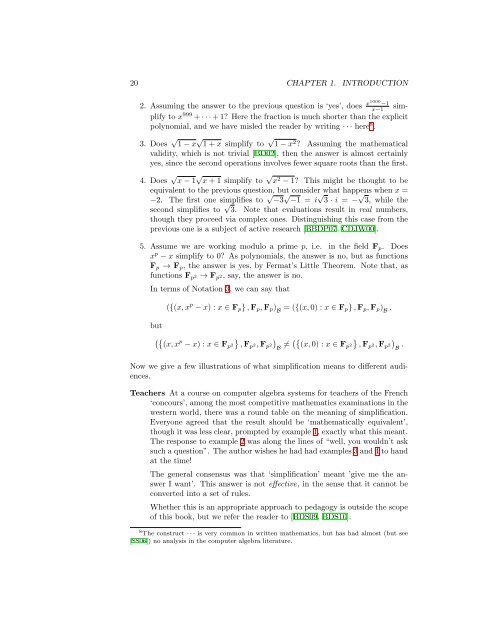Contents - Student subdomain for University of Bath
Contents - Student subdomain for University of Bath
Contents - Student subdomain for University of Bath
Create successful ePaper yourself
Turn your PDF publications into a flip-book with our unique Google optimized e-Paper software.
20 CHAPTER 1. INTRODUCTION<br />
2. Assuming the answer to the previous question is ‘yes’, does x1000 −1<br />
x−1<br />
simplify<br />
to x 999 + · · · + 1? Here the fraction is much shorter than the explicit<br />
polynomial, and we have misled the reader by writing · · · here 8 .<br />
3. Does √ 1 − x √ 1 + x simplify to √ 1 − x 2 ? Assuming the mathematical<br />
validity, which is not trivial [BD02], then the answer is almost certainly<br />
yes, since the second operations involves fewer square roots than the first.<br />
4. Does √ x − 1 √ x + 1 simplify to √ x 2 − 1? This might be thought to be<br />
equivalent to the previous question, but consider what happens when x =<br />
−2. The first one simplifies to √ −3 √ −1 = i √ 3 · i = − √ 3, while the<br />
second simplifies to √ 3. Note that evaluations result in real numbers,<br />
though they proceed via complex ones. Distinguishing this case from the<br />
previous one is a subject <strong>of</strong> active research [BBDP07, CDJW00].<br />
5. Assume we are working modulo a prime p, i.e. in the field F p . Does<br />
x p − x simplify to 0? As polynomials, the answer is no, but as functions<br />
F p → F p , the answer is yes, by Fermat’s Little Theorem. Note that, as<br />
functions F p 2 → F p 2, say, the answer is no.<br />
In terms <strong>of</strong> Notation 3, we can say that<br />
but<br />
({(x, x p − x) : x ∈ F p } , F p , F p ) B<br />
= ({(x, 0) : x ∈ F p } , F p , F p ) B<br />
,<br />
({<br />
(x, x p }<br />
− x) : x ∈ F p 2 , Fp 2, F p 2)<br />
≠ ({ }<br />
(x, 0) : x ∈ F<br />
B p 2 , Fp 2, F p 2)<br />
. B<br />
Now we give a few illustrations <strong>of</strong> what simplification means to different audiences.<br />
Teachers At a course on computer algebra systems <strong>for</strong> teachers <strong>of</strong> the French<br />
‘concours’, among the most competitive mathematics examinations in the<br />
western world, there was a round table on the meaning <strong>of</strong> simplification.<br />
Everyone agreed that the result should be ‘mathematically equivalent’,<br />
though it was less clear, prompted by example 1, exactly what this meant.<br />
The response to example 2 was along the lines <strong>of</strong> “well, you wouldn’t ask<br />
such a question”. The author wishes he had had examples 3 and 4 to hand<br />
at the time!<br />
The general consensus was that ‘simplification’ meant ’give me the answer<br />
I want’. This answer is not effective, in the sense that it cannot be<br />
converted into a set <strong>of</strong> rules.<br />
Whether this is an appropriate approach to pedagogy is outside the scope<br />
<strong>of</strong> this book, but we refer the reader to [BDS09, BDS10].<br />
8 The construct · · · is very common in written mathematics, but has had almost (but see<br />
[SS06]) no analysis in the computer algebra literature.












![[Luyben] Process Mod.. - Student subdomain for University of Bath](https://img.yumpu.com/26471077/1/171x260/luyben-process-mod-student-subdomain-for-university-of-bath.jpg?quality=85)



